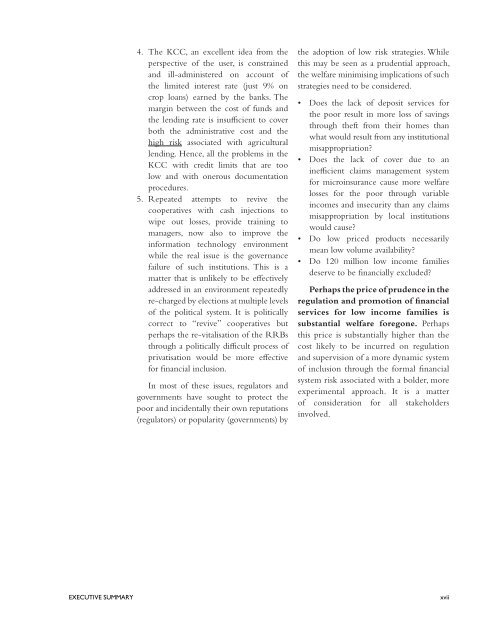Promoting Financial Inclusion - United Nations Development ...
Promoting Financial Inclusion - United Nations Development ...
Promoting Financial Inclusion - United Nations Development ...
You also want an ePaper? Increase the reach of your titles
YUMPU automatically turns print PDFs into web optimized ePapers that Google loves.
4. The KCC, an excellent idea from the<br />
perspective of the user, is constrained<br />
and ill-administered on account of<br />
the limited interest rate (just 9% on<br />
crop loans) earned by the banks. The<br />
margin between the cost of funds and<br />
the lending rate is insufficient to cover<br />
both the administrative cost and the<br />
high risk associated with agricultural<br />
lending. Hence, all the problems in the<br />
KCC with credit limits that are too<br />
low and with onerous documentation<br />
procedures.<br />
5. Repeated attempts to revive the<br />
cooperatives with cash injections to<br />
wipe out losses, provide training to<br />
managers, now also to improve the<br />
information technology environment<br />
while the real issue is the governance<br />
failure of such institutions. This is a<br />
matter that is unlikely to be effectively<br />
addressed in an environment repeatedly<br />
re-charged by elections at multiple levels<br />
of the political system. It is politically<br />
correct to “revive” cooperatives but<br />
perhaps the re-vitalisation of the RRBs<br />
through a politically difficult process of<br />
privatisation would be more effective<br />
for financial inclusion.<br />
In most of these issues, regulators and<br />
governments have sought to protect the<br />
poor and incidentally their own reputations<br />
(regulators) or popularity (governments) by<br />
the adoption of low risk strategies. While<br />
this may be seen as a prudential approach,<br />
the welfare minimising implications of such<br />
strategies need to be considered.<br />
• Does the lack of deposit services for<br />
the poor result in more loss of savings<br />
through theft from their homes than<br />
what would result from any institutional<br />
misappropriation?<br />
• Does the lack of cover due to an<br />
inefficient claims management system<br />
for microinsurance cause more welfare<br />
losses for the poor through variable<br />
incomes and insecurity than any claims<br />
misappropriation by local institutions<br />
would cause?<br />
• Do low priced products necessarily<br />
mean low volume availability?<br />
• Do 120 million low income families<br />
deserve to be financially excluded?<br />
Perhaps the price of prudence in the<br />
regulation and promotion of financial<br />
services for low income families is<br />
substantial welfare foregone. Perhaps<br />
this price is substantially higher than the<br />
cost likely to be incurred on regulation<br />
and supervision of a more dynamic system<br />
of inclusion through the formal financial<br />
system risk associated with a bolder, more<br />
experimental approach. It is a matter<br />
of consideration for all stakeholders<br />
involved.<br />
EXECUTIVE SUMMARY<br />
xvii

















